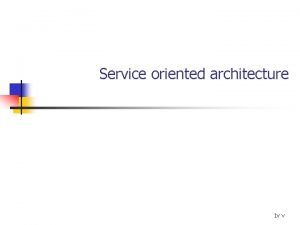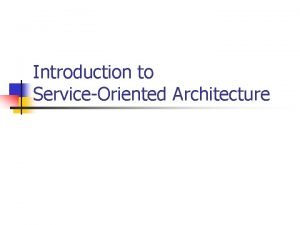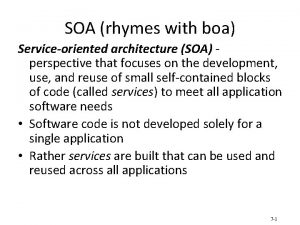What is ServiceOriented Architecture ServiceOriented Architecture SOA views




- Slides: 4

What is Service-Oriented Architecture? � Service-Oriented Architecture (SOA) views software as providing a set of services. Applications built using an SOA style deliver functionality as services that can be used or reused when building applications or integrating within the enterprise or trading partners. � Uses open standards to integrate software assets as services � Standardizes interactions of services � Services become building blocks that form business flows � Services can be reused by other applications 1

What is a Service? �A service is a reusable component that can be used as a building block to form larger, more complex businessapplication functionality. �A service may be as simple as “get me some person data, ” or as complex as “process a disbursement. ” �A service provides a discrete business function that operates no data. Its job is to ensure that the business functionality is applied consistently, returns predictable results, and operates within the quality of service required. 2

Characteristics of a Service � Supports open standards for integration: Although proprietary integration mechanisms may be offered by the SOA infrastructure, SOA’s should be based on open standards. Open standards ensure the broadest integration compatibility opportunities. � Stateless: The service does not maintain state between invocations. It takes the parameters provided, performs the defined function, and returns the expected result. If a transaction is involved, the transaction is committed and the data is saved to the database. � Location agnostic: Users of the service do not need to worry about the implementation details for accessing the service. The SOA infrastructure will provide standardized access mechanisms with service-level agreements. 3

Architectural Choke Point �Monolithic �Extremely complex �Very tightly coupled �Difficult to find clean integration points �Lack of standards makes it difficult to integrate �Rigid architecture makes even small changes complex and costly 4







